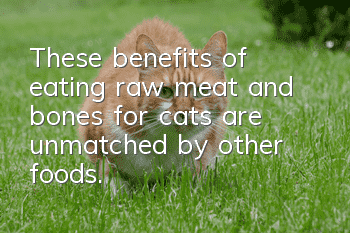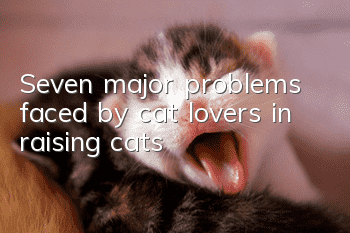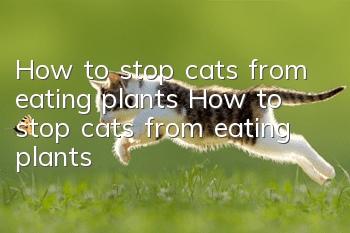These benefits of eating raw meat and bones for cats are unmatched by other foods.

Cats have been domesticated to this day, and they still have wild nature at their core, but maybe as the documentary says at the end, cats will eventually shed their wild nature and live better with us. Especially after becoming pet cats, they are fed cat food, but cats are purely carnivorous in nature. They are "little tigers".
Big cats and domestic cats have the same body structure, oral structure, and tooth shape. The large canines are used to tear prey limbs, and the sharp back molars are used to cut flesh like scissors. Therefore, feeding raw meat and bones is a feeding method that pursues closeness to nature. In other words, it is the nature of cats to eat raw meat and bones.
Cat food has three fatal and irreparable flaws:
1. Extremely low water content
2. Extremely high in carbohydrates
3. Poor source of protein
Low moisture
We often say that cats should drink more water. The reason behind this is because pet cats are basically chronically dehydrated based on their current diet of dry cat food. Cats evolved from desert animals. They are adapted to dry climates. The food they eat in the natural environment is rich in water (65-75%), so that they can survive with less water. At the same time, It also creates the characteristic that they are not good at drinking enough water.
Cats eating cat food seem to be able to drink water, but in the end, when the water intake is calculated, the daily water intake when eating dry food is only one-half to two-thirds of that when eating canned food/meat. If things go on like this, the cat's insufficient water intake causes the urine concentration to be too high, which in turn causes feline lower urinary system diseases.
High starch, high carbohydrate
Cats’ body structures are adapted to meat, and their carbohydrate intake only accounts for 2%, while dry cat food accounts for more than 25%-50%. In addition, cats themselves lack the targeted enzyme secretion channels that other mammals have, so their ability to break down and digest carbohydrates is particularly low, and they also lack amylase in their saliva.
Moreover, carbohydrates are directly broken down into sugar after entering the body, and cats do not need so much sugar. The abnormally high starch ratio not only causes excessive obesity in cats, but also affects the development of diabetes.
Poor protein source
Although the ingredients of cat food are marked with a seemingly abundant protein ratio, most of them are protein powder extracted from corn, soybeans, peas, and potatoes. This incomplete protein, which comes from grains and vegetables, does not provide all the essential amino acids and therefore simply cannot meet the nutritional needs of cats.
Other issues with dry cat food
In order to make cats eat dry cat food, most dry cat food is sprayed with flavor enhancers. Only this kind of food attractant can make cats eat dry cat food. The manufacturing of "food attractants" has spawned a whole product chain to ensure that cats eat dry cat food. Eat this totally unhealthy food.
Due to poor storage conditions and lax supervision, dry food is contaminated by mold, fungi, and mycotoxins. Sometimes dry food even contains more bacterial flora than raw meat. Moreover, the materials used to make pet food are also scraps of low quality.
Are there many parasites in raw meat and bones?
Speaking of the most suffocating anxiety in raising pets, it is probably the problem of "parasites", and the proposition "You cannot keep pets when you are pregnant, as the baby will be born with deformities" makes people talk about "parasites" even more.
There are many types of parasites, but not all of them have an impact on the health of cats. Cats infected with parasites are largely spread through free-range feeding and ingestion of animal intestines/feces, and are not simply misinterpreted as "eating raw meat." infected with parasites".
But what you need to ensure is that the meat you buy comes from industrially farmed animals from regular sources, and you should observe whether there are any abnormalities in the meat when purchasing. You are more assured if you buy frozen products, because long-term freezing will eliminate most parasites that are harmful to cats. It should be reminded that raw meat and bones must not be fed raw to the digestive tract of any animal, freshwater fish, shrimp, amphibians, reptiles, or insects. Pork is the "hardest hit area". The simple and crude way is not to feed pork.
Is it acceptable for a cat’s digestive system to feed raw meat?
Most pet cats currently eat cat food. If they switch to eating raw meat, will their digestive systems have problems? Can kittens tolerate it? This is a question that every cat owner has doubts about. In fact, this question is easy to answer. The key point is that cats eat meat from their mothers and fetuses. The correct method of feeding raw meat and bones is more suitable for the cat’s physique than cat food. It fully mobilizes the cat’s gastrointestinal function and is more conducive to the cat’s health.
As for cats adapting to eating raw meat, it is a process. For cats who have never eaten raw meat, you can fry the surface of the meat or mix it with cans with high meat content to increase acceptance. The adaptation process Keep adding more raw meat until it is fully accepted. The same process goes from meat to bones. Cats that have eaten cat food for a long time cannot quickly accept the hardness of bones. You can continue to train the cat's teeth to bite by moving from small pieces (meat/minced meat) to larger pieces of meat. Then transition to bones.
However, it is not recommended to mix dry food with raw meat (you can use canned food with a lot of meat to help adapt, but it is not recommended to mix dry food with raw meat), because the intestines will be overwhelmed when digesting carbohydrates and other plant components, and will not be able to cope with it.This method can effectively deal with raw food, which will damage the cat’s digestive system and increase the cat’s risk of bacterial infection.
As for whether kittens can adapt to eating raw meat and bones, it is actually easier for kittens to adapt to it. But it should be noted that when a kitten is newly brought home, it also needs an adaptation process. It is necessary to give the kitten a little adaptation process to the environment, and then train it to eat raw meat and bones in the same step-by-step manner. Of course, if there is an adult cat fed raw meat and bones, the kitten can also learn to eat raw meat and bones in the same way. Pregnant female cats actually need more nutrition, and feeding raw meat and bones can also help her to conceive, give birth and breastfeed better.
By the way, cat food is concentrated "nutrients" produced at high temperatures, and it is very difficult for the cat's digestive system to digest these "nutrients".
What if a cat hides meat and bones?
This problem is very common, and friends always say that cats hide bones and meat under pillows, sofas and beds. This involves cultivating the cat's eating habits and developing a regular eating time and frequency for your owner, that is, a fixed food ration. Eat within a certain time and take away any leftover food after this time. Do not leave food in the rice bowl. For example, if you don’t finish eating within half an hour, take away the remaining food and wait until the next feeding time to give the food. In this way, the cat will finish the meal and not "take it away".
Preparing raw meat requires balanced nutrition:
The most important thing about a homemade diet is that it needs to be nutritionally balanced. To achieve this, the proportion of animal tissue in the diet is key. The feeding habits followed by raw meat and bones never require every meal to be precise. This is easy to understand, because humans/animals do not count every meal. A balanced diet over a period of time is sufficient.
This cycle is usually one week. Cat diet proportions follow the following:
7-10% bone (can be replaced by eggshell powder in the early stage, the amount will be added later)
4-5% liver (must)
80-85% muscle tissue (including heart, gizzards)
5% other internal organs (brain, waist, pancreas, spleen, optional, best if available)
When feeding raw meat and bones, you need the following supplements (additives):
Eggshell powder
An extremely important source of calcium, it does not reach 7% of bone intake before each meal. Prepare a measuring spoon (purchased on Taobao, 1/2 teaspoon and 1/8 teaspoon are both OK). One-half teaspoon or 2.5ml of eggshell powder corresponds to approximately 450g of pure meat/liver, which can be appropriateWhen floating 20-30%. Don't put it based on your feelings! The actual amount is more than you think.
Vitamin E
Purchase vitamin E soft capsules for human use, 100IU version, and must be [natural type]. The price is about 30 yuan, so there is no need to buy high-priced products. The frequency is one pill a week. For immature cats or small cats, this cycle can be changed to once a week and a half to two weeks.
Comprehensive vitamin B
Water-soluble vitamins, there is no excess. Therefore, you can buy the human version directly from the drugstore for 2 yuan for 100 tablets. Just add one tablet every one to two days. If you can eat a lot of duck meat and duck liver, you can omit it depending on the situation.
Taurine
A large number of hearts and a sufficient proportion of liver actually provide sufficient taurine, but it is written here to be on the safe side. Freezing doesn't completely destroy the taurine, but it does lose some of it.
There is no overdose value for the time being, just give a pinch every two days. Purchase on Taobao, within 20 yuan. There is no need to buy high-priced imported products, they are all produced in China and have the same quality. It should be noted that although this synthetic taurine is provided, it does not mean that your cat will stop eating hearts. It is better to eat more hearts. If you can eat poultry, cattle and sheep hearts regularly and in sufficient amounts, you can omit them.
Omega-3 fatty acids
Feed your cat 100-200g every week to a week and a half (based on a 9-pound adult cat). Freshly purchased, cooked and boneless saury/spanfish/mackerel/green fish, etc. can meet the demand for omega3 fatty acids (please do not use cod) , tuna, dragon fish instead). At the same time, fish is an extremely important source of vitamin D and iodine, so it is recommended to eat fish instead of fish oil.
All meat used for raw bone feeding needs to be frozen:
When thawing, seal it first and place it in the refrigerator in advance or use warm/cold water to thaw quickly. After thawing any food, place it in a sealed bag and soak it in hot water at 40-50 degrees until it is warm (about 15-20 minutes) and then you can feed it. Avoid defrosting in the air at high room temperature!
It must be sealed and defrosted. If the food is not sealed and soaked in water, not only will it lose most of its smell, but it will also give more opportunities for bacterial proliferation and water-soluble vitamins to be lost.
So, how much do you need to feed and how often do you need to feed it?
Before deciding to feed raw meat, you can take your cat toDo a checkup. Check whether the little guy is overweight or malnourished. Regardless of whether it is overweight or malnourished, the feeding amount should be based on the normal weight of cats of the same age. Of course, you can also measure it through simple methods.
Daily food intake for adult cats/dogs: 3%-4% of body weight, increase as appropriate (such as in estrus/lactation)
Daily food intake of young cats/dogs: 10%, 8%, 6% of body weight (decreasingly with age)
Daily food intake of obese cats/dogs: 2%-2.5% of body weight
It is recommended that children should be fed at least 3 times a day, 4 or 5 times is better; adults should be fed at least 2 times a day, but 3 times a day is definitely better. Feeding too few times may cause vomiting.
The interval between each feeding must be at least 4-5 hours. Overly frequent or excessive meals in a single time may easily cause diarrhea and soft stools. Cats and dogs need appropriate fasting and hunger to promote normal body function, and they do not need to eat too much.
Finally, there is a recipe example: a preliminary version for beginners
This basic version of the planner is not suitable for use for more than half a year. As the cat slowly grows up and adapts, I believe that parents can gradually figure out "exclusive recipes" based on the owner's needs when formulating recipes.
Handling precautions:
Please feel free to change the order, even if you feed all chicken on one day, but the missing parts should be made up within a week. Vitamin B and taurine can be added to any meal every day, once a week, while eggshell powder is required for every meal.
Again, the liver accounts for 5% of the total. The more types of meat, the better. Just eat chicken. One-half teaspoon of eggshell powder, that is, 2.5ml corresponding to 450g-500g of meat, is a necessary additive for the junior version.
- How to prevent hairball disease in cats? A must-read for cat owners!
- How to make cats exercise? Is there any good way?
- What’s wrong with the cat that keeps meowing so early in the morning?
- What should I do if my cat has a bad gastrointestinal condition? Don’t change food frequently
- Introduction to causes of dehydration in cats
- How to Treat Demodex in Cats
- Why do cats eat cat litter?
- Why do so few people keep Persian cats?
- Why is the Jin Jian Lay cat breed so expensive?
- Why do Japanese bobtail cats need to be neutered?



